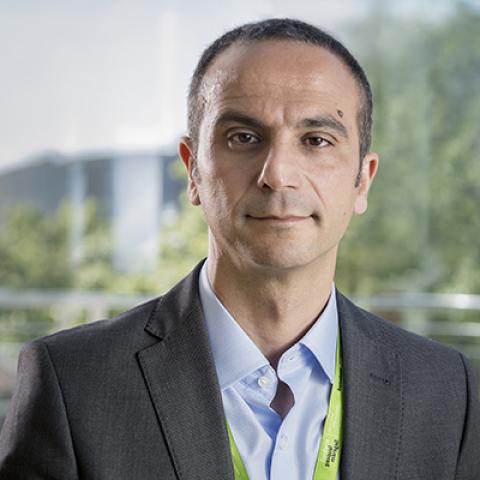31 May | 2023
We use artificial intelligence to validate a new biomarker of brain aging

This is the first time that the BBRC has applied machine learning techniques to the study of brain aging.
A team led by the Barcelonaβeta Brain Research Center (BBRC), a research center of the Pasqual Maragall Foundation, has developed a new biomarker of brain aging based on more than 22,600 magnetic resonance images. This new biomarker has made it possible to demonstrate, for the first time, that the presence of pathological changes in Alzheimer's disease is associated with accelerated brain aging, even in cognitively healthy people.
The results of the study, supported by the ”la Caixa” Foundation, help to better understand the relationship between the brain aging process and neurodegenerative diseases, an urgent priority for developing effective strategies in the face of the growing aging of the population.
Biomarkers are objective measures that provide information about a disease or biological process. In the case of brain aging, certain morphological characteristics, such as altered thickness or volume in specific regions of the brain, may indicate accelerated aging. The researchers have used a machine learning model to analyze these parameters from magnetic resonance imaging.
This study is the first to demonstrate the association between brain biological age and the presence of Alzheimer's biomarkers and risk factors (such as the presence of beta amyloid and tau proteins or the APOE-ε4 genotype) in a total of 2,314 persons, healthy or with mild cognitive impairment. The study also shows the relationship between brain aging and markers of neurodegeneration and cerebrovascular pathology. The findings, published in the scientific journal Elife, position this new indicator as a potentially useful tool in the diagnosis of various brain diseases.
Artificial intelligence: a pioneering methodology to study Alzheimer’s
The difference between chronological age (the time since birth) and biological brain age (calculated from neuroimaging techniques) provides an estimate of whether the brain has aged more rapidly than expected. It is what is known as the brain-age delta, and is an indicator of biological brain aging. Those with an estimated brain age higher than their chronological age might have an “older” brain than expected, while an individual with an estimated brain age lower than their chronological age would have a “younger” brain.
"Although age is the main risk factor for Alzheimer's disease and most neurodegenerative diseases, the biological mechanisms that explain this association are still poorly understood," explains Irene Cumplido, predoctoral researcher in the Neuroimaging Research Group of the BBRC and first author of the work. "For the study of age, it is necessary to have objective markers of biological brain aging, beyond chronological age, in the same way that biomarkers are available for Alzheimer's," she points out.
In this work, the research team has trained a predictive model to calculate the brain age of healthy men and women, using more than 22,000 measurements obtained from magnetic resonance imaging. These images have been sourced from the UK Biobank, a large-scale biomedical database containing health and genetic information on half a million UK participants.
This is the first time that the BBRC has applied machine learning techniques to the study of brain aging, a methodology that has gained recent popularity thanks to its ability to identify relevant patterns from complex data. "These models learn the association between chronological age and brain morphological characteristics extracted from magnetic resonance imaging, which predicts a brain age for each individual”, explains Dr. Verónica Vilaplana, associate professor in the Department of Signal Theory and Communications of the Polytechnic University of Catalonia and also author of the study.
“A growing amount of research in the last two years has focused on the use of neuroimaging techniques to develop a marker of biological brain aging,” says Dr. Juan Domingo Gispert, head of the BBRC Neuroimaging Research Group. “Unlike previous studies, the new biomarker that we have developed is validated against several biological markers and risk factors associated with aging, so our study demonstrates the validity of our method as a biomarker of brain biological aging with relevance for various neurodegenerative diseases”.
The largest cohort to date to predict brain age
In the study, a total of 22,661 measurements from images from the UK Biobank data set were used to predict the brain age of more than 2,300 healthy people or people with mild cognitive impairment from four independent cohorts: ALFA +, promoted by the “la Caixa” Foundation (380 people), ADNI (719 people), EPAD (808) and OASIS (407).
"We know that accelerated aging of the brain has been found in neurodegenerative disorders such as Alzheimer's disease, but it was necessary to compare these data with specific biological markers of the disease," says Cumplido. To this end, researchers have studied the associations of accelerated brain aging with various biomarkers and risk factors for Alzheimer's in healthy individuals, such as the presence of beta amyloid and tau proteins, the APOE-ε4 genotype, the main genetic risk factor for Alzheimer's disease, and other markers of neurodegeneration and cerebrovascular disease. In addition, a stratified analysis by sex was introduced, in order to study the differences between men and women with respect to brain age.
The estimate of accelerated brain aging was associated with abnormal beta-amyloid deposits, more advanced stages of Alzheimer's disease, and the presence of the APOE-e4 genotype; particularly useful results for potential prevention interventions.
Bibliographic reference
Cumplido-Mayoral, Irene; García-Prat, Marina; Operto, Grégory et al. ‘Biological brain age prediction using machine learning on structural neuroimaging data: multi-cohort validation against biomarkers of Alzheimer's disease and neurodegeneration stratified by sex’, Elife, 2023, 12: e81067. https://doi.org/10.7554/eLife.81067











